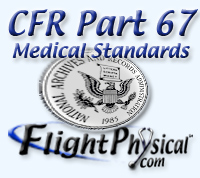|
Medical
Certificate
Pilot Type
|
First-Class
Airline Transport Pilot
|
Second-Class
Commercial Pilot
|
Third-Class
Private Pilot
|
| DISTANT VISION |
20/20 or better in each eye separately, with or
without correction. |
20/40 or better in each eye separately, with or
without correction. |
| NEAR VISION |
20/40 or better in each eye separately (Snellen
equivalent), with or without correction, as measured at 16 inches.
|
INTERMEDIATE
VISION |
20/40 or better in each eye separately (Snellen
equivalent), with or without correction at age 50 and over,
as measured at 32 inches. |
No requirement. |
| COLOR VISION |
Ability to perceive those colors necessary for
safe performance of airman duties. |
| HEARING |
Demonstrate hearing of an average conversational
voice in a quiet room, using both ears at 6 feet, with the back
turned to the examiner or pass one of the audiometric
tests below. |
| AUDIOLOGY |
Audiometric speech discrimination test: Score
at least 70% reception in one ear.
Pure tone audiometric test. Unaided, with thresholds no worse
than: |
| |
| |
|
500 Hz
|
1,000 Hz
|
2,000 Hz
|
3,000 Hz
|
| Better Ear |
35 Db
|
30 dB
|
30 dB
|
40 dB
|
| Worst Ear |
35 dB
|
50 dB
|
50 dB
|
60 dB
|
|
| ENT |
No ear disease or condition manifested by, or
that may reasonably be expected to maintained by, vertigo or
a disturbance of speech or equilibrium. |
| PULSE |
Not disqualifying per se. Used to determine cardiac
system status and responsiveness. |
| BLOOD PRESSURE |
No specified values stated in the standards. The
current guideline maximum value is 155/95. |
ELECTRO-
CARDIOGRAM (ECG) |
At age 35 and
annually after age 40 for 1st Class. |
Not routinely required for 2nd or 3rd class certificates. |
| MENTAL |
No diagnosis of psychosis, or bipolar disorder,
or severe personality disorders. |
SUBSTANCE
DEPENDENCE AND
SUBSTANCE ABUSE |
A diagnosis or medical history of "substance
dependence" is disqualifying unless there is established
clinical evidence, satisfactory to the Federal Air Surgeon,
of recovery, including sustained total abstinence from the substance(s)
for not less than the preceding 2 years. A history of "substance
abuse" within the preceding 2 years is disqualifying. "Substance"
includes alcohol and other drugs (i.e., PCP, sedatives and hynoptics,
anxiolytics, marijuana, cocaine, opioids, amphetamines, hallucinogens,
and other psychoactive drugs or chemicals). |
DISQUALIFYING
CONDITIONS |
Examiner must disqualify if the applicant has
a history of: (1) Diabetes
mellitus requiring hypoglycemic medication; (2) Angina
pectoris;
(3) Coronary heart
disease that has been treated or, if untreated, that has
been symptomatic or clinically significant; (4) Myocardial
infarction;
(5) Cardiac valve
replacement; (6) Permanent
cardiac pacemaker;
(7) Heart replacement;
(8) Psychosis;
(9) Bipolar disorder
(10) Personality
Disorder; (11) Substance
dependence; (12) Substance
abuse;
(13) Epilepsy; (14)
Disturbance
of consciousness and without satisfactory explanation of
cause, and (15) Transient
loss of control of nervous system function(s) without satisfactory
explanation of cause. |

 Last Updated:
Last Updated: